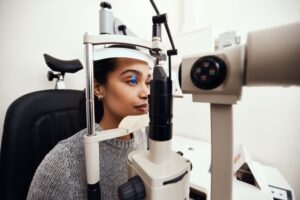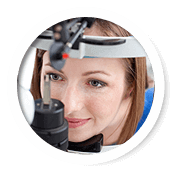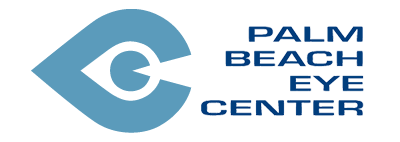 Routine eye exams are important to detect vision changes and disorders as early as possible. At Palm Beach Eye Center, we use the most advanced technology of today in order to provide you with the best possible treatment. Comprehensive eye exams can detect disorders affecting the whole body, such as diabetes, high blood pressure, blocked arteries and others.
Routine eye exams are important to detect vision changes and disorders as early as possible. At Palm Beach Eye Center, we use the most advanced technology of today in order to provide you with the best possible treatment. Comprehensive eye exams can detect disorders affecting the whole body, such as diabetes, high blood pressure, blocked arteries and others.
Our examinations include a comprehensive evaluation of the optical visual system of your eye, which determines if you have Refractive Errors such as nearsightedness (myopia), farsightedness (hyperopia), astigmatism and presbyopia (the need for reading glasses for people starting in their forties). These are called lower-order aberrations. You will also be evaluated for higher-order aberrations, which are optical imperfections of the eye. You will obtain eye prescriptions for glasses or contact lenses, depending on your needs.
How Does A Comprehensive Eye Exam Work?
Comprehensive eye exams are crucial to your eye health, vision and overall well-being. Regular eye exams and vision screenings should be part of your preventive health care as many eye diseases, vision problems and other ocular concerns don’t show obvious symptoms at first. Early diagnosis is key in treating eye problems and preventing or stopping vision loss. During these eye exams, our ophthalmologist will ask about vision-related issues you’re experiencing and conditions affecting your overall health.
Visual acuity measurements are taken during comprehensive exams. These tests measure how distinctly you can see at various distances using letters on a chart. Visual acuity is measured and written as a fraction. Excellent vision is considered 20/20, but people with nearsightedness, farsightedness or astigmatism require corrective eyewear to see objects clearly. A visual acuity of 20/40, for example, means that you can see an object from 20 feet as compared to a person with 20/20 who would be able to see the same object from 40 feet. To be able to obtain a driver’s license in Florida, a visual acuity of 20/40 in one eye is required if the other eye is 20/200 or worse. Otherwise, the minimal requirement would be to have a level of at least 20/70 in either eye or both eyes.
If you need glasses or contact lenses, further tests are done to find the correct focusing power for your lenses using a phoropter. A phoropter device uses various lenses in front of your eyes to determine which strength improves your vision and is combined with a handheld lighted instrument called a retinoscope. Some tools automatically calculate focusing power, and the lens power is tweaked based on your input for the clearest vision. The prescription for glasses or contact lenses is measured in diopters. The negative sign is used in front of the diopter value for nearsightedness and the positive sign is used for farsightedness.
Other tests are done to determine eye health and how well the eyes focus, move and work together. Dilating eye drops are often used to see the eye’s internal structures to detect changes that indicate eye disease or a health condition, such as diabetes. Intraocular eye pressure is measured to test for glaucoma. Our ophthalmologist recommends bringing sunglasses to wear after comprehensive eye exams because the dilating eye drops enlarge your pupils and can make bright lights uncomfortable. Our office provides you with disposable sunglasses at the end of your visit if your eyes are dilated during that specific visit.
How Is a Comprehensive Eye Exam Different From a Vision Screening?
Comprehensive eye exams discuss your family health history and your medical history and go beyond screening for vision problems. These appointments measure visual acuity and involve various tests to evaluate eye health and visual function. Refractive errors are still assessed, along with how well the eyes move and focus together. Depending on the exam’s findings, additional tests may be used to diagnose eye conditions or diseases, such as diabetic retinopathy, glaucoma, keratoconus and cataracts.
How Often Should Children and Adults Have Eye Exams?
 The American Academy of Ophthalmology (AAO) recommends infants have eye exams between six and 12 months old depending on their risk factors for refractive errors and whether they exhibit warning signs of vision problems. Children ages three to five should have an eye exam at least once and again before first grade. It’s recommended that school-age kids have eye exams every year until they’re 18. Premature infants, children born with low birth weight or those with a family history of refractive errors and eye conditions should be evaluated regularly.
The American Academy of Ophthalmology (AAO) recommends infants have eye exams between six and 12 months old depending on their risk factors for refractive errors and whether they exhibit warning signs of vision problems. Children ages three to five should have an eye exam at least once and again before first grade. It’s recommended that school-age kids have eye exams every year until they’re 18. Premature infants, children born with low birth weight or those with a family history of refractive errors and eye conditions should be evaluated regularly.
The AAO recommends adults ages 18 to 64 have an eye exam every two years if they have a low risk for eye problems and annually if they have a higher chance of refractive errors or eye disease. Adults 65 and older need annual eye exams to diagnose eye disease early because they are more likely to develop cataracts, age-related macular degeneration and other eye diseases.
People with certain health conditions, such as diabetes, need annual screenings regardless of age because they may develop permanent vision changes or vision loss due to health concerns.
Choosing Corrective Eyewear: Glasses, Contact Lenses or Both?
Many patients wish to use contact lenses to avoid the hassles of prescription eyeglasses that may get scratched or bent easily. Some may wear eyeglasses in the evening and contact lenses during the day or for certain activities. Choosing the right corrective eyewear depends on your needs, eye health and lifestyle. Cost may be a factor for some patients.
Several types of contact lenses are available, ranging from rigid gas-permeable lenses worn for up to six months to planned replacement contacts that are soft daily wear, lenses worn for two weeks, one month or switched quarterly. Each contact lens type has pros and cons, and our ophthalmologist will discuss your options and recommend a lens type that fits your lifestyle and needs. It is imperative to avoid wearing extended wear contact lenses during sleep, as doing so increases the risk of potentially blinding corneal infections eightfold. It is definitely safer to take a minute of your day to remove your contact lenses before bedtime. Giving your eyes a rest from contact lens wear will also prevent other problems like corneal neovascularization (formation of new blood vessels on the cornea), irritation and inflammation. This is why Dr. Khouri always recommends against the use of extended wear contact lenses.
Schedule an Eye Exam at Palm Beach Eye Center
Comprehensive eye exams can improve your quality of life with better vision and diagnose eye problems early on. Schedule your eye exam at Palm Beach Eye Center in West Palm Beach, Florida, by calling (561) 366-8300.









